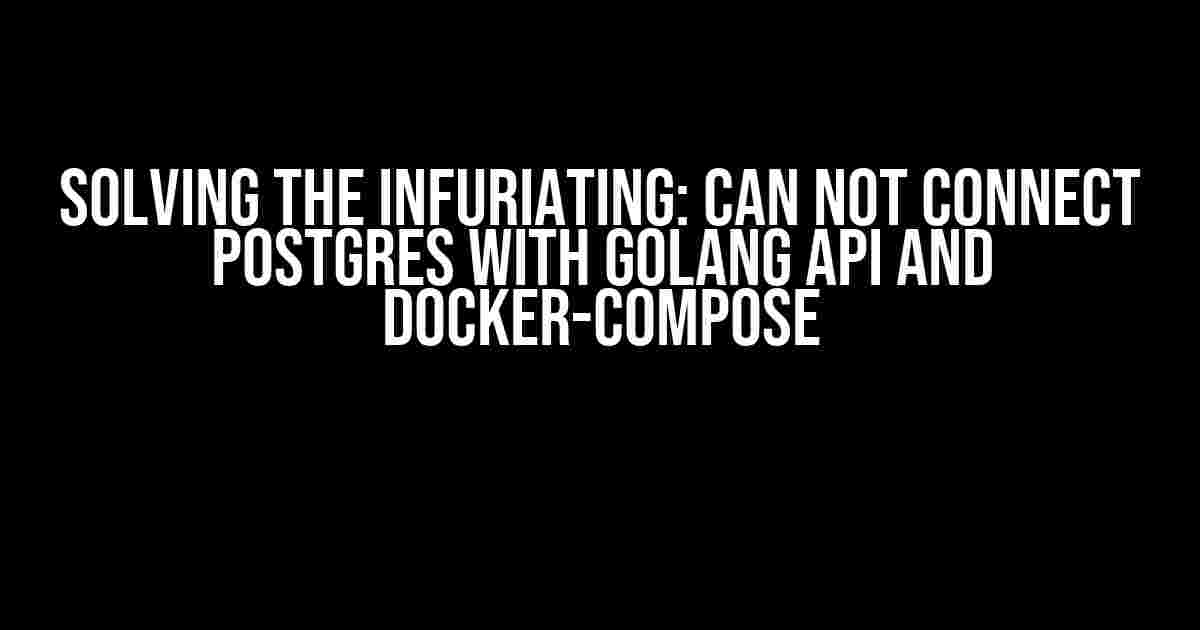Have you ever spent hours trying to connect your Golang API to a Postgres database using docker-compose, only to be met with frustrating error messages and cryptic error codes? You’re not alone! In this article, we’ll take a deep dive into the common pitfalls and provide clear, step-by-step instructions to get you up and running in no time.
Understanding the Architecture
Before we dive into the troubleshooting, let’s take a step back and understand the architecture we’re working with:
- A Golang API (our main application)
- A Postgres database (our data storage)
- Docker-compose (our containerization tool)
Our goal is to connect these three components seamlessly. Sounds simple, right? Well, as we’ll see, the devil is in the details.
Common Pitfalls and Solutions
Let’s tackle the most common errors and their solutions:
Error 1: Connection Refused
Error message: “dial tcp [::1]:5432: connect: connection refused”
This error usually occurs when the Postgres container is not running or not reachable. Here’s how to fix it:
- Make sure your docker-compose.yml file is correctly configured:
version: '3' services: db: image: postgres environment: POSTGRES_USER: myuser POSTGRES_PASSWORD: mypassword POSTGRES_DB: mydb ports: - "5432:5432" - Verify that the Postgres container is running by checking the docker-compose logs:
docker-compose logs -f db
- If the container is not running, start it with:
docker-compose up -d db
Error 2: Authentication Failure
Error message: “password authentication failed for user “myuser””
This error occurs when the Golang API is unable to authenticate with the Postgres database. Here’s how to fix it:
- Double-check your database credentials in your Golang API:
func main() {
connStr := "user=myuser password=mypassword dbname=mydb sslmode=disable"
_, err := sql.Open("postgres", connStr)
if err != nil {
log.Fatal(err)
}
}
- Ensure that the environment variables are correctly set in your docker-compose.yml file:
environment: POSTGRES_USER: myuser POSTGRES_PASSWORD: mypassword POSTGRES_DB: mydb
Error 3: DNS Resolution Failure
Error message: “no such host”
This error occurs when the Golang API is unable to resolve the hostname of the Postgres container. Here’s how to fix it:
- Update your docker-compose.yml file to use a fixed IP address for the Postgres container:
services: db: ... ports: - "127.0.0.1:5432:5432" - In your Golang API, use the fixed IP address to connect to the Postgres database:
connStr := "host=127.0.0.1 user=myuser password=mypassword dbname=mydb sslmode=disable"
Best Practices for Connecting to Postgres with Golang and Docker-Compose
Avoid common mistakes and ensure a smooth connection by following these best practices:
| Practice | Description |
|---|---|
| Use Environment Variables | Store database credentials as environment variables to avoid hardcoding sensitive information. |
| Fixed IP Address | Use a fixed IP address for the Postgres container to avoid DNS resolution issues. |
| Container Networking | Use container networking to ensure seamless communication between containers. |
| Error Handling | Implement robust error handling to catch and debug connection issues. |
Conclusion
Connecting a Golang API to a Postgres database using docker-compose can be a daunting task, but by following these step-by-step instructions and best practices, you’ll be well on your way to a seamless and efficient connection. Remember to stay patient, persistent, and methodical in your troubleshooting, and you’ll overcome even the most infuriating errors!
Still stuck? Try checking the official documentation for:
Happy coding!
Frequently Asked Question
Getting stuck with connecting Postgres with Golang API and docker-compose? Don’t worry, we’ve got you covered! Here are some frequently asked questions and answers to help you troubleshoot the issue.
Q1: Why can’t I connect to Postgres from my Golang API using docker-compose?
A1: Make sure you have the correct database URL in your Golang API. The URL should be in the format `postgres://username:password@host:port/database`. Also, ensure that the `host` is set to the service name of the Postgres container in your `docker-compose.yml` file, not `localhost` or `127.0.0.1`.
Q2: How do I configure my docker-compose file to allow communication between my Golang API and Postgres?
A2: In your `docker-compose.yml` file, make sure to define both your Golang API and Postgres services. Use the `depends_on` directive to specify that the Golang API depends on the Postgres service. This ensures that the Postgres service is started before the Golang API.
Q3: What are the common environment variables I need to set for Postgres in my docker-compose file?
A3: You’ll need to set the following environment variables for Postgres: `POSTGRES_USER`, `POSTGRES_PASSWORD`, `POSTGRES_DB`, and `POSTGRES_HOST`. These variables should match the credentials and database name you’re using in your Golang API.
Q4: Why am I getting a “connection refused” error when trying to connect to Postgres from my Golang API?
A4: This error usually occurs when the Postgres service is not started or is not listening on the correct port. Check your `docker-compose` logs to ensure that the Postgres service is running and listening on the expected port (usually 5432).
Q5: How do I troubleshoot my docker-compose setup to find the root cause of the connection issue?
A5: Use the `docker-compose logs` command to view the logs for your Postgres and Golang API services. This will help you identify any errors or issues that might be preventing the connection. You can also use tools like `docker-compose exec` to execute a command inside a running container and debug the issue.

